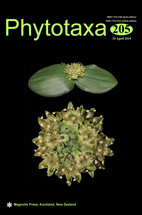Abstract
The family Cleomaceae is in need of taxonomic revision, which begins here with a set of taxa informally recognized as the North American cleomoid clade. This group is evaluated first because molecular-based analyses almost comprehensively sample this lineage. These investigations revealed that the two largest genera, Cleomella and Peritoma, are para- or polyphyletic. Strong support from molecular data necessitates name changes for these taxa. Furthermore, controversy exists on the recognition of the remaining genera, owing to morphological variation and specialization. Three possible classification scenarios are described to accommodate monophyletic lineages based on previously-published evidence. The option to create the single large genus Cleomella is proposed, and as a result one new name, Cleomella oxystyloides, is provided, and 12 new combinations are made: C. arborea, C. arborea var. angustata, C. arborea var. globosa, C. californica, C. jonesii, C. lutea, C. multicaulis, C. palmeri, C. platycarpa, C. refracta, C. serrulata, and C. sparsifolia. Two lectotypes and one isolectotype are designated, and another lectotype is confirmed.

